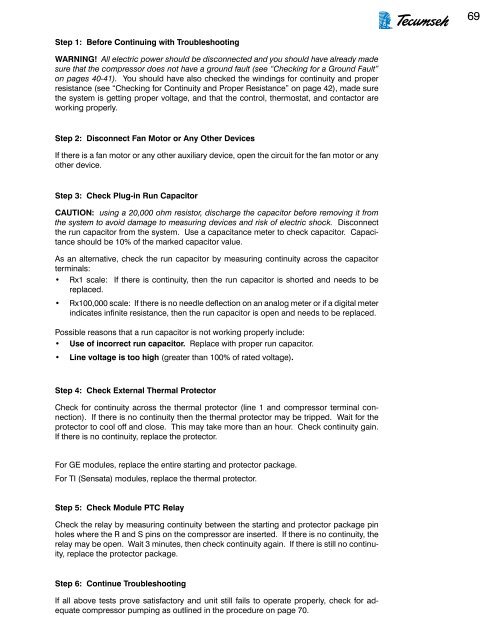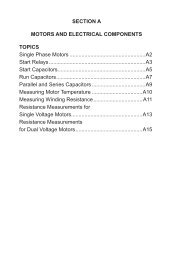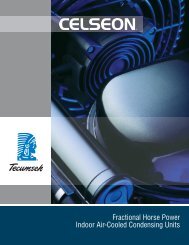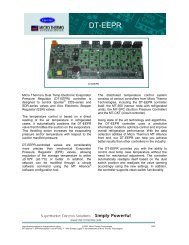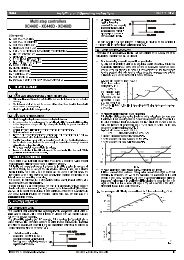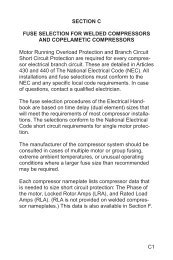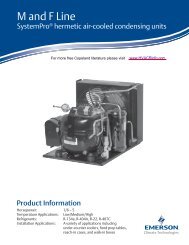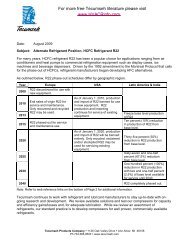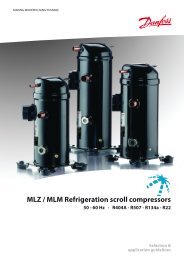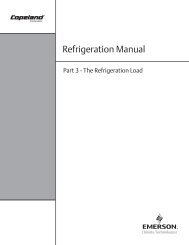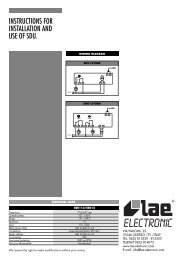Hermetic Compressor - Tecumseh
Hermetic Compressor - Tecumseh
Hermetic Compressor - Tecumseh
Create successful ePaper yourself
Turn your PDF publications into a flip-book with our unique Google optimized e-Paper software.
69<br />
Step 1: Before Continuing with Troubleshooting<br />
WARNING! All electric power should be disconnected and you should have already made<br />
sure that the compressor does not have a ground fault (see “Checking for a Ground Fault”<br />
on pages 40-41). You should have also checked the windings for continuity and proper<br />
resistance (see “Checking for Continuity and Proper Resistance” on page 42), made sure<br />
the system is getting proper voltage, and that the control, thermostat, and contactor are<br />
working properly.<br />
Step 2: Disconnect Fan Motor or Any Other Devices<br />
If there is a fan motor or any other auxiliary device, open the circuit for the fan motor or any<br />
other device.<br />
Step 3: Check Plug-in Run Capacitor<br />
CAUTION: using a 20,000 ohm resistor, discharge the capacitor before removing it from<br />
the system to avoid damage to measuring devices and risk of electric shock. Disconnect<br />
the run capacitor from the system. Use a capacitance meter to check capacitor. Capacitance<br />
should be 10% of the marked capacitor value.<br />
As an alternative, check the run capacitor by measuring continuity across the capacitor<br />
terminals:<br />
• Rx1 scale: If there is continuity, then the run capacitor is shorted and needs to be<br />
replaced.<br />
• Rx100,000 scale: If there is no needle deflection on an analog meter or if a digital meter<br />
indicates infinite resistance, then the run capacitor is open and needs to be replaced.<br />
Possible reasons that a run capacitor is not working properly include:<br />
• Use of incorrect run capacitor. Replace with proper run capacitor.<br />
• Line voltage is too high (greater than 100% of rated voltage).<br />
Step 4: Check External Thermal Protector<br />
Check for continuity across the thermal protector (line 1 and compressor terminal connection).<br />
If there is no continuity then the thermal protector may be tripped. Wait for the<br />
protector to cool off and close. This may take more than an hour. Check continuity gain.<br />
If there is no continuity, replace the protector.<br />
For GE modules, replace the entire starting and protector package.<br />
For TI (Sensata) modules, replace the thermal protector.<br />
Step 5: Check Module PTC Relay<br />
Check the relay by measuring continuity between the starting and protector package pin<br />
holes where the R and S pins on the compressor are inserted. If there is no continuity, the<br />
relay may be open. Wait 3 minutes, then check continuity again. If there is still no continuity,<br />
replace the protector package.<br />
Step 6: Continue Troubleshooting<br />
If all above tests prove satisfactory and unit still fails to operate properly, check for adequate<br />
compressor pumping as outlined in the procedure on page 70.


